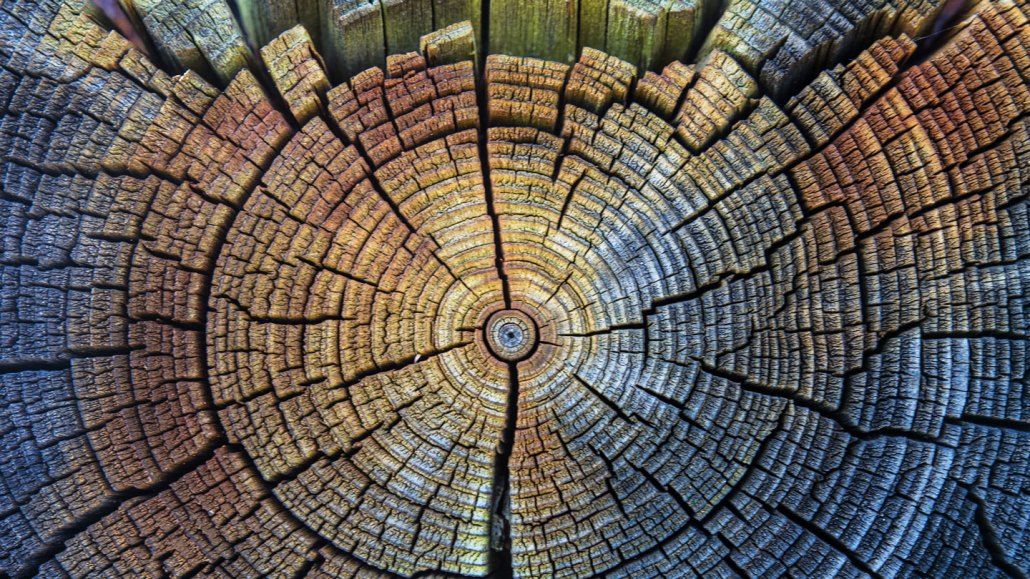
As trees grow, they add rings to their trunks. Scientists can measure the chemical compositions of these rings to learn about the environment’s past.
Richard Malak/Getty
A cryptic chemical signature of unknown origins, hidden for centuries inside the trunks of Earth’s trees, just became even more mysterious.
In the last decade, scientists have discovered traces on Earth of six intense bursts of radiation, known as Miyake events, scattered over the last 9,300 years. The most popular explanation is that these mysterious signatures were left behind by massive solar storms, leading some scientists to warn that the next Miyake event could cripple the world’s electrical grid. But new research, published in the October Proceedings of the Royal Society A, suggests that more than just solar flares might be behind the enigmatic radiation.
The finding underscores the need for further investigations into these strange bursts, which could potentially harm our society in the future, says physicist Gianluca Quarta of the University of Salento in Lecce, Italy, who was not involved in the study. “Something is not fitting with what we know at the moment.”
Miyake events were first discovered in trees. As trees grow, their trunks accrue layers, or rings, which lock in chemical signatures from their surroundings. By analyzing the composition of individual tree rings, researchers can uncover clues about environmental conditions going back thousands of years (SN: 6/1/20).
In 2012, physicist Fusa Miyake of Nagoya University in Japan was studying Japanese cedar tree rings when she found a sharp spike in radiocarbon — a variant of carbon that can form when cosmic radiation strikes Earth’s atmosphere — in rings dating to about A.D. 774. Since then, five other similar bursts, now named Miyake events, have been detected in tree rings around the world as well as in polar ice cores.
Due to the spikes’ global occurrence, many scientists contend that the events have an extraterrestrial origin. The most popular explanation is that especially large solar storms, or flares, blasted Earth with big bursts of radiation (SN: 2/26/21).
The most powerful solar storm in recorded history was the 1859 Carrington event, which broke telegraph lines and sparked a circuit fire in Pittsburgh. The radiation levels associated with Miyake events are more than 80 times those of the Carrington event, says physicist Benjamin Pope of the University of Queensland in St. Lucia, Australia. “They could pose serious risks to global technology.”
But the solar storm story has holes. Radiation levels from the 774 event would have been too high to have come from a single solar flare, some researchers have suggested. And ice cores, which can also store chemical traces of solar flares, have not yet yielded evidence of increased solar activity for every Miyake event.
So, Pope and his colleagues put the leading hypothesis to the test. They analyzed all publicly available tree ring data on the six Miyake events using computer simulations of Earth’s carbon cycle. This allowed the team to calculate the duration, timing and amplitude of each event.
If Miyake events are tied to solar activity, they could align with the solar maxima, which occur roughly every 11 years when solar flares become more frequent. But the researchers found no correlation between Miyake events and any phase of the solar cycle. What’s more, the researchers found that two of the events appeared to last longer than a year — unexpectedly long for solar storms, which typically rage for hours or days.
And if solar flares did cause the events, then trees nearer the poles, where Earth’s protective magnetic field is weaker, should contain higher levels of Miyake event radiation. But the researchers found no such trend.
The findings don’t rule out the solar flare hypothesis, Pope says. Insufficient tree ring data could be hiding a link between solar activity and Miyake events, he says. New Antarctic ice-core data — being analyzed by researchers at the Australian Nuclear Science and Technology Organization and hopefully published next year — may provide more answers.
Solar flares could still be behind the events, Quarta agrees. Nuances in Earth’s carbon cycle not captured by the simulations could influence the findings. For instance, trees might metabolize radiocarbon at different rates depending on species or latitude, he says.
Though the mystery remains unsolved, Pope isn’t losing sleep over another Miyake event happening anytime soon. There’s about a 1 percent chance of one happening in the next decade, he says. “I’d be more worried about being hit by a bus on my walk to the office.”






